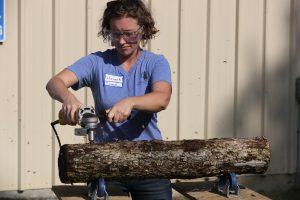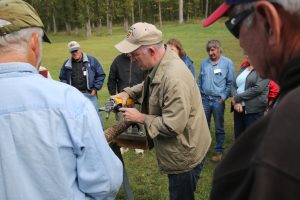This story also appears in our University of Missouri College of Agriculture, Food and Natural Resources’ Agricultural Research Center Magazine. Stop by your local Research Center to pick up a copy! You can view the magazine online by clicking here: Road to Discovery.
Agroforestry incorporates trees and shrubs into crop and animal farming systems. The goal is to create environmental, economic and social benefits across the farm.
One of those agroforestry practices is mushroom cultivation forest farming, where landowners can generate an extra income – or extra food – through growing their own
varieties of mushrooms.
Gregory Ormsby Mori, outreach coordinator, and Hannah Hemmelgarn, educational program coordinator, both with the University of Missouri College of Agriculture, Food and Natural Resources’ Center for Agroforestry, host a number of forest farming workshops across the state every year. Each workshop focuses on how landowners, farmers and natural resource professionals can find opportunities to do forest farming.

a trio of mushrooms during their workshops
– shiitake, oyster and king stropharia. There are many other mushroom varieties that can be grown. The Horticulture and Agroforestry Research Center, near New Franklin,
has seven additional mushroom species on a
demonstration site, such as lion’s mane, reishi and hen-of-the-woods (maitake).
“Growing edible mushrooms can be an economically viable option for small landowners and can even fit in well with an overall forest management plan,” Ormsby Mori said.
Ormsby Mori and Hemmelgarn focus on a trio of mushrooms during their workshops – shiitake, oyster and king stropharia. There are many other mushroom varieties that can be grown. The Horticulture and Agroforestry Research Center, near New Franklin, has seven additional mushroom species on a demonstration site, such as lion’s mane, reishi and hen-of-the-woods (maitake).
Ormsby Mori said shiitake, oyster and king stropharia have proven production, viable markets and more accessibility.
“These three species are pretty easy to grow,” Ormsby Mori said.
The workshops include hands-on demonstrations, as Ormsby Mori and Hemmelgarn showcase just how easy it is to prepare mushrooms for growing. There are multiple techniques to grow mushrooms, including log inoculation, totems and woodchip beds.
“Mushrooms are different than plants in that they obtain their food from decaying organic matter,” Ormsby Mori said. “Plants obtain food through photosynthesis. That’s why we use logs or totems to grow mushrooms. They can feed off of that wood by decomposing the cellulose and lignin.”
Ormsby Mori said the perfect time to cut logs for inoculation is when the tree is dormant, before buds begin showing up on branches. With high temperatures, dry weather and hot winds, the summer months can be a dangerous time to inoculate.
The logs should be around three feet long and have no branches or knots. Oak trees, sugar maples and ironwood are all good species to use for log inoculation. The logs should be kept in a cool, shady area – making sure that they do not dry out.
“You want straight logs that are fresh,” Ormsby Mori said. “The wood needs to be healthy, without disease or damage.”
Holes are then drilled into the log, around an inch deep. The holes are filled with mushroom spawn. Once the hole is filled, hot wax is used to seal the opening. Ormsby Mori said it will take up to a year for the spawn to establish itself in the log.
“You have to monitor the light, shade and humidity after you seal the holes,” he said. “It’s incredibly important to make sure the logs don’t dry out after inoculating.”

accessibility.
Medium shade is important for the logs. Logs shouldn’t be stored in a basement-like setting. There needs to be air flow and some light. Too much light can be as big of a problem as too little light. The logs need to be close to the ground as well.
Totems, wood chips and straw can also all be used to grow mushrooms.
“Mushrooms are just one little enterprise that farmers, ranchers and landowners can add,” Ormsby Mori said. “There is definitely a sustainable forestry aspect to this.”
Ormsby Mori and Hemmelgarn host workshops in the Columbia area, as well as Springfield and St. Louis. There are no experience requirements, as the workshops generally feature hobbyists and farmers. There are more advanced workshops as well, which include the economics, marketing and production of mushroom forest farming.
“Adequate planning, a market survey and a thorough analysis of whether mushroom growing is right for you and your land is essential before diving in big,” Ormsby Mori said. “For simply getting started as a hobbyist and learning how to grow mushrooms, there are many resources and growers guides available. For launching a new enterprise, seek appropriate technical guidance from your local MU Extension agent or other experts, and do your homework before initiating a new commercial venture or introducing a new specialty crop into your farming operation.”
To learn more about growing mushrooms in a forest setting, contact Ormsby Mori at 573-884-2874 or OrmsbyG@missouri.edu, or contact Hemmelgarn at 573-882-8321 or hemmelgarnh@missouri.edu.